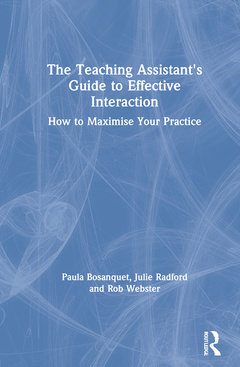Description
The Teaching Assistant's Guide to Effective Interaction (2nd Ed.)
How to Maximise Your Practice
Authors: Bosanquet Paula, Radford Julie, Webster Rob
Language: English
Subject for The Teaching Assistant's Guide to Effective Interaction:
Keywords
Process Success Criteria; IRF Pattern; DISS; UK Deployment; Webster; IRF; Blatchford; Diss Project; special educational needs; Professional Development; pupil independence; SEND Code; pupil voice; TA Workforce; teaching assistants; Social Constructivist Learning Theory; talk; TA Deployment; learning; TA Support; interaction; Delivering Intervention Programmes; pedagogy; Group Work Skills; Scaffolding; Non-pedagogical Roles; Prompt Sheets; WPR Model; Scaffolding Framework; TA Role; Dialogic Talk; UK Education System; Scaffolding Learning; Wider Issues; Intermental Development Zone; Exploratory Talk; TAs Work
166.30 €
In Print (Delivery period: 14 days).
Add to cartPublication date: 05-2021
· 17.4x24.6 cm · Hardback
37.68 €
In Print (Delivery period: 14 days).
Add to cartPublication date: 05-2021
· 17.4x24.6 cm · Paperback
Description
/li>Contents
/li>Readership
/li>Biography
/li>
This second edition of The Teaching Assistant?s Guide to Effective Interaction is the definitive guide to teaching assistant-pupil interaction, fully updated with examples from schools that have implemented techniques from the first edition. An invaluable professional development tool for classroom support staff and the teachers who work with them, this new edition answers the need for specific, practical guidance on the role of the teaching assistant.
This practical and accessible guide sets out a role for teaching assistants that focuses on developing pupils? independence and ownership of learning, with key learning points now summarised in each chapter. Based on a classroom-tested framework and covering the main contexts in which teaching assistants work, it includes a range of strategies and reflective activities to help improve the support provided to pupils in everyday settings. This book sets out successful strategies for:
- Responding to additional needs
- Understanding the principles behind effective classroom talk
- Carefully scaffolding pupils? learning
- Delivering intervention programmes
The Teaching Assistant?s Guide to Effective Interaction is an essential read for all teaching assistants and will also be of interest to school leaders, SENCOs and teachers in both primary and secondary schools who wish to improve their deployment of teaching assistants and their own interactions with pupils.
Used in combination with Maximising the Impact of Teaching Assistants in Primary Schools, The Teaching Assistant?s Guide to Effective Interaction is a comprehensive and unrivalled resource for supporting school workforce improvement.
1. The teaching assistant as scaffolder 2. The value of planning the right task and pupils taking an active role in interactions 3. The principles of scaffolding 4. Scaffolding strategies 5. Assessment for learning: Providing feedback for teachers and pupils 6. Promoting effective group working 7. Delivering intervention programmes
Paula Bosanquet is a Senior Teaching Fellow in Special Educational Needs at UCL Institute of Education, London. A former primary teacher, she has worked extensively as a trainer with teaching assistants, schools and local authorities.
Julie Radford is an Associate Professor at UCL Institute of Education, London. She researches classroom interactions involving children with special educational needs and disabilities. Julie has authored 30 academic publications and has supervised several doctoral students on this topic.
Rob Webster is an Associate Professor at UCL Institute of Education, London. He researches and writes about special educational needs and inclusion, and he developed the Maximising the Impact of Teaching Assistants programme.




